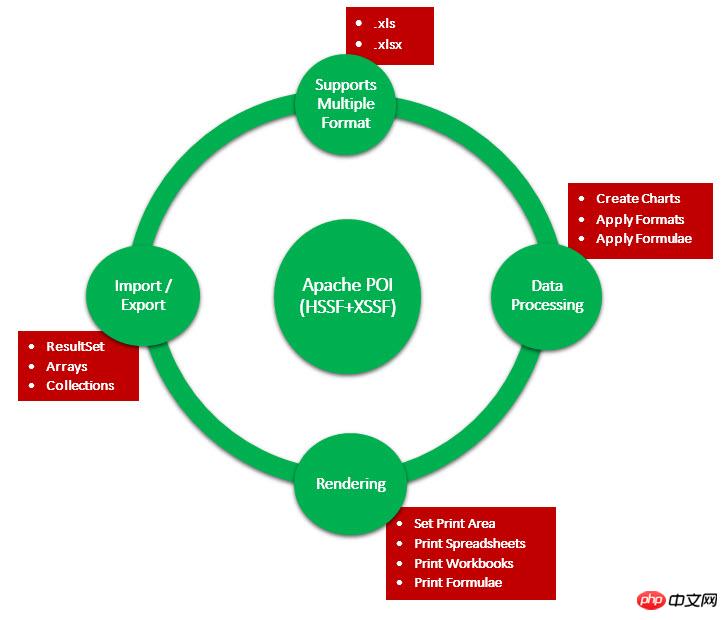Home >Java >javaTutorial >Java reads excel
Java reads excel
- 大家讲道理Original
- 2017-08-19 13:49:092225browse
Reading excel tables with Java
Poi technology is generally used to read excel tables, but what is this technology?
What is Apache POI?
Apache POI is a popular API that allows programmers to create, modify and display MS Office files using Java programs. This open source library developed by the Apache Software Foundation uses Java to distribute the design or modification of Microsoft Office files. It contains classes and methods to decode user input data or files into MS Office documents.
Apache POI
Apache POI is a 100% open source library provided by the Apache Software Foundation. Most small and medium-sized application development mainly relies on Apache POI (HSSF + XSSF). It supports all basic functions of the Excel library; however, rendering and text extraction are its main features.

Workbook
This is the super interface for all classes that create or maintain Excel workbooks. It belongs to the org.apache.poi.ss.usermodel package. There are two classes that implement this interface, as follows:
HSSFWorkbook: This class has methods for reading and writing Microsoft Excel files in .xls format. It is compatible with Microsoft Office97-2003 version.
XSSFWorkbook: This class has methods for reading and writing Microsoft Excel and OpenOffice XML files in the format .xls or .xlsx. It is compatible with MS-Office version 2007 or higher.
HSSFWorkbook
It is a high-level class in the org.apache.poi.hssf.usermodel package. It implements the Workbook interface for .xls format in Excel files. Listed below are some methods and constructors under this class.
Constructor of class
| S.No. | Constructor and description |
|---|---|
| 1 |
##HSSFWorkbook() When creating a new HSSFWorkbook object from scratch. |
|
HSSFWorkbook(DirectoryNode directory, boolean preserveNodes) Create a specific directory Create a new HSSFWworkbook object. |
|
|
HSSFWorkbook(DirectoryNode directory, POIFSFileSystem fs, boolean preserveNodes) Given A POIFSFileSystem object and a specific directory, it creates an SSFWorkbook object to read the specified workbook. |
|
|
HSSFWorkbook(java.io.InputStream s) Create an input stream using when creating a new HSSFWorkbook object. |
|
| HSSFWorkbook(java.io.InputStream s, boolean preserveNodes) Build The POI file system of the input stream. | ##6|
| HSSFWorkbook(POIFSFileSystem fs) |
A new HSSFWorkbook object constructed using the POIFSFileSystem object hour. | 7
| HSSFWorkbook(POIFSFileSystem fs, boolean preserveNodes) |
Given a POIFSFileSystem object When reading the specified workbook, it creates a new HSSFWorkbook object. |
- fs: It is the file system that contains the POI of the book stream.
- preservenodes : This is an optional parameter that determines whether to preserve other nodes like macros. It consumes a lot of memory because it stores all POIFileSystem in memory (if set).
- Note: The HSSFWorkbook class contains a number of methods; however, they are only compatible with the XLS format. In this tutorial, the focus is on the latest version of the Excel file format. Therefore, the methods of the HSSFWorkbook class are not listed here. If you need the methods of these classes, please refer to the POI-HSSFWorkbook class API at https://poi.apache.org/apidocs/org/apache/poi/hssf/usermodel/HSSFWorkbook.html.
| 1 | |||||||||||||||||||||||||||||
|---|---|---|---|---|---|---|---|---|---|---|---|---|---|---|---|---|---|---|---|---|---|---|---|---|---|---|---|---|---|
| ##XSSFWorkbook() |
Create a new XSSFworkbook object from scratch. 2 |
||||||||||||||||||||||||||||
| XSSFWorkbook(java.io.File file) |
Constructs from the given XSSFWorkbook object in the file. 3 |
||||||||||||||||||||||||||||
| XSSFWorkbook(java.io.InputStream is) |
Construct an XSSFWorkbook object , by buffering the entire input stream into memory and then opening an OPCPackage object for it. 4 |
||||||||||||||||||||||||||||
| XSSFWorkbook(java.lang.String path) |
Build a given The full path to the file in the XSSFWorkbook object.
SheetSheet is an interface in the org.apache.poi.ss.usermodel package. It is used to create high or low level files with specific names. Superinterface for all classes of spreadsheets. The most common type of spreadsheet is a worksheet, which is represented as a grid of cells. HSSFSheetThis is a class in the org.apache.poi.hssf.usermodel package. It can create Excel spreadsheets, which allows in sheet mode and table data format. Constructor of class
line
Cell public static void excel() throws Exception { //用流的方式先读取到你想要的excel的文件
FileInputStream fis=new FileInputStream(new File(System.getProperty("user.dir")+"/src/excel.xls")); //解析excel
POIFSFileSystem pSystem=new POIFSFileSystem(fis); //获取整个excel
HSSFWorkbook hb=new HSSFWorkbook(pSystem);
System.out.println(hb.getNumCellStyles()); //获取第一个表单sheet
HSSFSheet sheet=hb.getSheetAt(0); //获取第一行
int firstrow= sheet.getFirstRowNum(); //获取最后一行
int lastrow= sheet.getLastRowNum(); //循环行数依次获取列数
for (int i = firstrow; i list=new ArrayList(); for (int j = firstcell; j <lastcell>0) {
user.setUsername(list.get(1));
user.setPassword(list.get(2));
}
BaseDAO dao=new BaseDAO();
dao.save(user);
System.out.println();
}
}
fis.close();
}</lastcell>
|
The above is the detailed content of Java reads excel. For more information, please follow other related articles on the PHP Chinese website!

